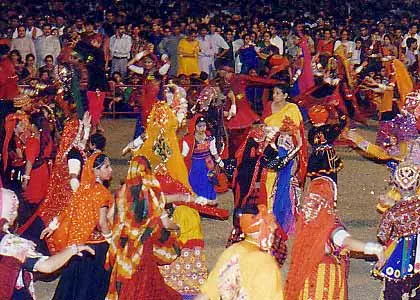The festival of Navratri (nav = nine and ratri = nights) lasts for 9 days with three days each devoted to worship of Maa Durga, the Goddess of Valor, Ma Lakshmi, the Goddess of Wealth and Maa Saraswati, the Goddess of Knowledge. During the nine days of Navratri, feasting and fasting take precedence over all normal daily activities amongst the Hindus. Evenings give rise to the religious dances in order to worhip Goddess Durga Maa.
The beginning of spring and the beginning of autumn are two very important junctions of climatic and solar influence. These two periods are taken as sacred opportunities for the worship of the Divine Mother. The dates of the festival are determined according to the lunar calendar. Being the oldest religion in the world, Hinduism has numerous belief systems.
In Hinduism the adherents believe in one omnipresent Deity but may worship Her/Him in any of the numerous manifestations that are prevalent all over India
The 9 nights festival of Navratri begins on the first day of Ashwina of the bright fortnight. Seeds are sown, sprouting is watched, the planets are consecrated, and on the 8th and 9th days, Goddess Durga, Vijayashtami and Mahanavami are worshipped. The Devi Mahatmya and other texts invoking the Goddess who vanquished demons are cited.
1st - 3rd day of Navratri
On the first day of the Navaratras, a small bed of mud is prepared in the puja room and barley seeds are sown on it. These initial days are dedicated to Durga Maa, the Goddess of power and energy.
4th - 6th day of Navratri
During these days, Lakshmi Maa, the Goddess of peace and prosperity is worshipped.
7th - 8th day of Navratri
7th - 8th day of Navratri
These final days belong to Saraswati Maa who is worshipped to acquire the spiritual knowledge. This in turn will free us from all earthly bondage. But on the 8th day of this colourful festival, yagna (holy fire) is performed.
Mahanavami
The festival of Navratri culminates in Mahanavami. On this day Kanya Puja is performed. Nine young girls representing the nine forms of Goddess Durga are worshiped.
Navaratri is celebrated five times a year. They are Vasanta Navaratri, Ashadha Navaratri, the Sharada Navaratri, and the Poushya/Magha Navaratri. Of these, the Sharada Navaratri of the month of Puratashi and the Vasanta Navaratri of the Vasanta kala are very important.
1. Vasanta Navaratri: Basanta Navrathri, also known as Vasant Navratras, is the festival of nine days dedicated to the nine forms of Shakti (Mother Goddess) in the spring season (March–April). It is also known as Chaitra Navratra. The nine days of festival is also known as Raama Navratri.
2. Gupta Navaratri: Gupta Navratri, also referred as Ashadha or Gayatri or Shakambhari Navratri, is nine days dedicated to the nine forms of Shakti (Mother Goddess) in the month of Ashadha (June–July). Gupta Navaratri is observed during the Ashadha Shukla Paksha (waxing phase of moon).
3. Sharana Navaratri: This is the most important of the Navratris. It is simply called Maha Navratri (the Great Navratri) and is celebrated in the month of Ashvina. Also known as Sharad Navaratri, as it is celebrated during Sharad (beginning of winter, September–October).
4. Poushya Navaratri: Poushya Navratri is nine days dedicated to the nine forms of Shakti (Mother Goddess) in the month of Pousha (December–January). Poushya Navaratri is observed during the Pousha Shukla Paksha (waxing phase of moon).
5. Magha Navaratri: Magha Navratri, also referred as Gupta Navratri, is nine days dedicated to the nine forms of Shakti (Mother Goddess) in the month of Magha (January–February). Magha Navaratri is observed during the Magha Shukla Paksha (waxing phase of moon).
"Shloka"
Sarva mangala mangalye shive sarvartha sadhike |
Sharanye trayambake gauri, Narayani namostute ||
Sharanye trayambake gauri, Narayani namostute ||
Meaning: O Mother ! You are the personification of all that is auspicious, You are the benevolent form of Lord Shiva, You bestow Divine energy and help people achieve Righteousness, wealth, fulfill desires and Liberation, You are worthy of being surrendered to. Three eyes adorn You. O Narayani Devi, I pay obeisance to You !
Happy Navratri

Navratri/Navratra Festival Photos



























0 Comments